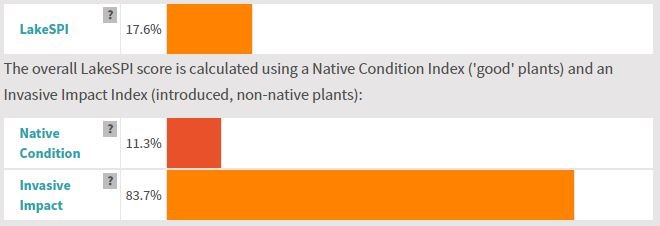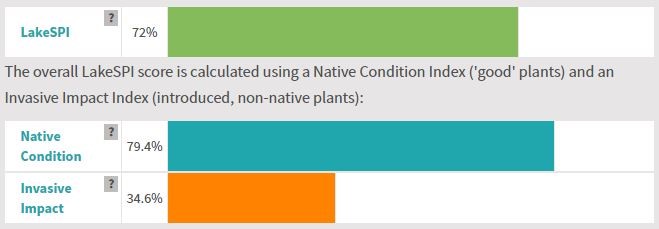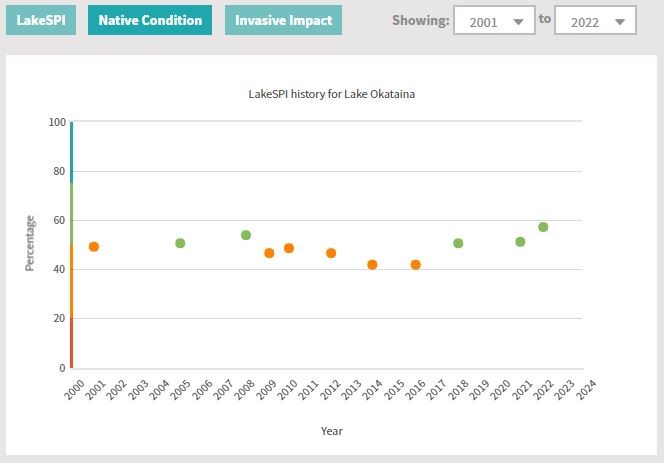Lake Submerged Plant Indicators (LakeSPI) is a method of characterising the aquatic plant community based on the composition of native and invasive plants growing in the lake. Presented as a percentage, the higher the LakeSPI score the better the overall health of the lake.
What do the LakeSPI scores mean?
The LakeSPI scores are presented as a range of percentages (%), which translate into in indication of ecological health, as shown in Table 1.
LAWA Icon |
LakeSPI Score |
Description |
| 75 - 100% | Excellent ecological health | |
| 50 - 75% | High ecological health | |
| 20 - 50% | Moderate ecological health | |
| 0 - 20% | Poor ecological health | |
| 0% | Non-vegetated (no plants present) |
Table 1. LakeSPI categories for lake ecological health.
How is LakeSPI measured?
Regional councils, unitary authorities, the Department of Conservation, NIWA and environmental consultants are all involved in collecting data used to calculate LakeSPI. These agencies carry out surveys of the plants growing under the surface of lakes using scuba divers. The data collected on these surveys is used to determine the:
-
Native Condition Index: the percentage of native plants within a lake. A high Native Condition Index is desirable.
-
Invasive Impact Index: the percentage of invasive plants within a lake. A high Invasive Impact is undesirable.
The native condition and invasive impact indices are used together to generate LakeSPI scores, which provides an overall indicator of lake ecological condition (see Figure 1 and 2).
You can see the how the indices work together for a lake by clicking on the “show more information” button under the LakeSPI tile on lakes pages on LAWA.

Figure 1. Example of a lake with LakeSPI showing poor ecological health, which is derived from the Native Condition Index in poor condition, and the Invasive Impact Index having a moderate to high negative impact on native vegetation.

Figure 2. Example of a lake with LakeSPI showing high ecological health, which is derived from Native Condition Index in good condition, and the Invasive Impact Index having a moderate impact on native vegetation.
In a pristine state, lakes within New Zealand would contain a diverse range of native submerged macrophytes (aquatic plants) growing from the lake edge towards the centre. Their extent is determined by the water clarity of maximum depth of the lake. Today, relatively few lakes remain in pristine condition because invasive macrophyte species and reduced water clarity have limited the diversity and extent of native macrophytes in most lakes.
What do the Native Condition Index and Invasive Impact Index numbers mean?
The National Policy Statement for Freshwater Management (2020) outlines attribute band assessments for submerged plants (natives and invasive species respectively). These are graded from A (excellent ecological condition) to D (poor ecological condition or non-vegetated state). If a lake is in the D band, it is considered degraded and may require councils to prepare a time-based action plan to achieve improvements in ecological condition.
Good ecological condition indicates native plants are intact and invasive plants are absent or having only a minor impact on native vegetation. Poor ecological condition suggests native submerged plants are impacted or absent and invasive weeds dominate the plant growth in the lake.
Table 2 below shows the range of percentages and a description of the ecological condition for each attribute band. If a lake is non-vegetated (i.e. has no aquatic plants) the Invasive Impact Index is 0%, but this score is not included in the A band because assessing the proportion of non-native vs. native plants cannot be done in lakes without submerged vegetation.
Attribute Band |
Submerged plants (native) |
Submerged plants (invasive) |
||
Native Condition Index |
Description |
Invasive Impact Index |
Description |
|
| >75% | Excellent ecological condition. Native submerged plant communities are almost completely intact. | 0% | No invasive plants present in the lake. Native plant communities remain intact. | |
| >50 and ≤75% | High ecological condition. Native submerged plant communities are largely intact. | >1 and ≤25% | Invasive plants having only a minor impact on native vegetation. Invasive plants will be patchy in nature co-existing with native vegetation. Often major week species not present or in early stages of invasion. | |
| ≥20 and ≤50% | Moderate ecological condition. Native submerged plant communities are moderately impacted. | >25 and ≤90% | Invasive plants having a moderate to high impact on native vegetation. Native plant communities likely displaced by invasive week beds particularly in the 2 - 8 m depth range. | |
|
National bottom line |
20% | 90% | ||
| <20% | Poor ecological condition. Native submerged plant communities are largely degraded or absent. | >90% | Tall dense weed beds exclude native vegetation and dominate entire depth range of plant growth. The species concerned are likely hornwort and Egeria. | |
Table 2. Attribute bands for submerged plants (natives and invasive species) indicators.
Do submerged plant indicators change over time?
The ecological health of a lake can change over time as the proportion of native and/or invasive plants changes. You can see the historical LakeSPI, Native Condition Index and Invasive Impact Index data by selecting the indicator and time period of interest.

Find out more:
The LakeSPI displayed on LAWA is provided by NIWA using data collected by regional councils, unitary authorities, Department of Conservation and NIWA. You can find out more about LakeSPI and how it is measured by visiting the NIWA LakeSPI site.
